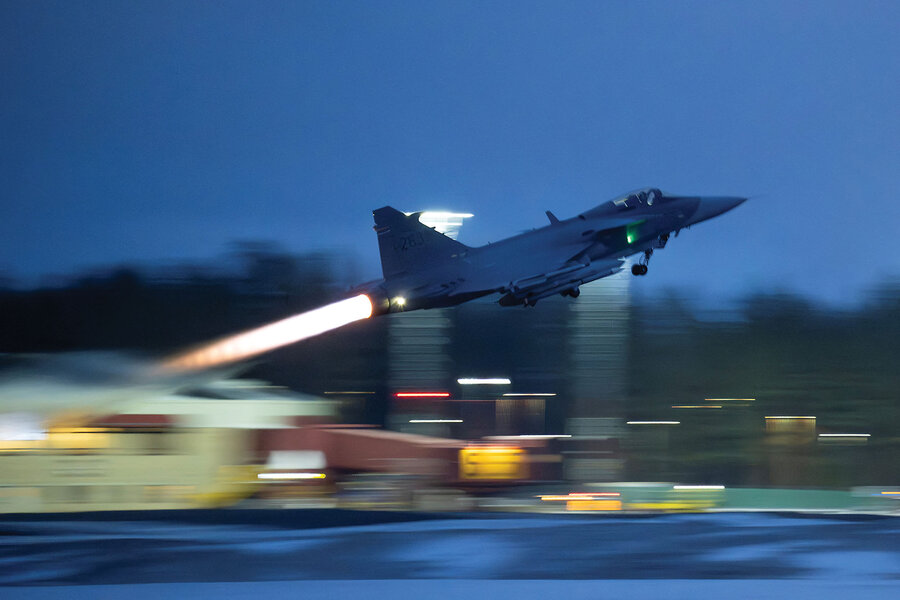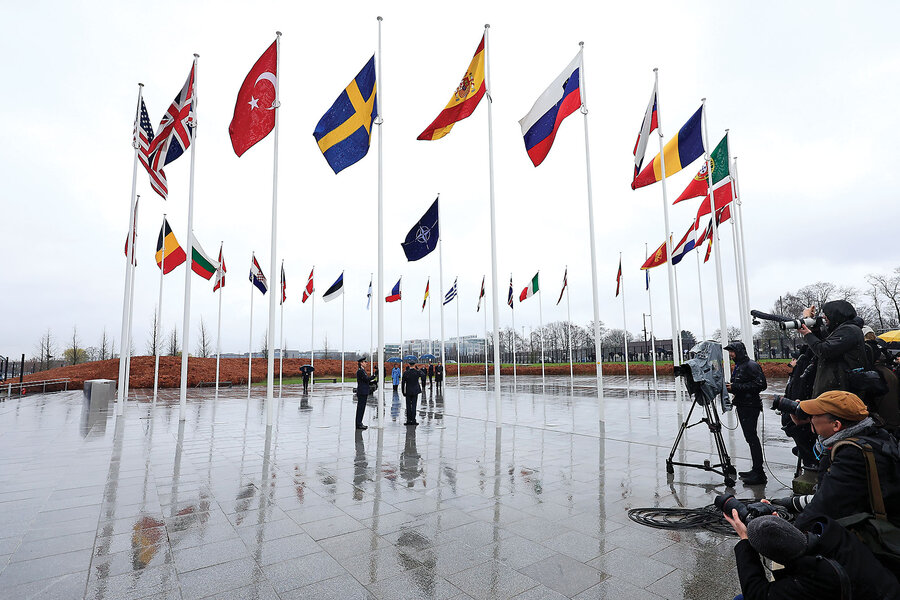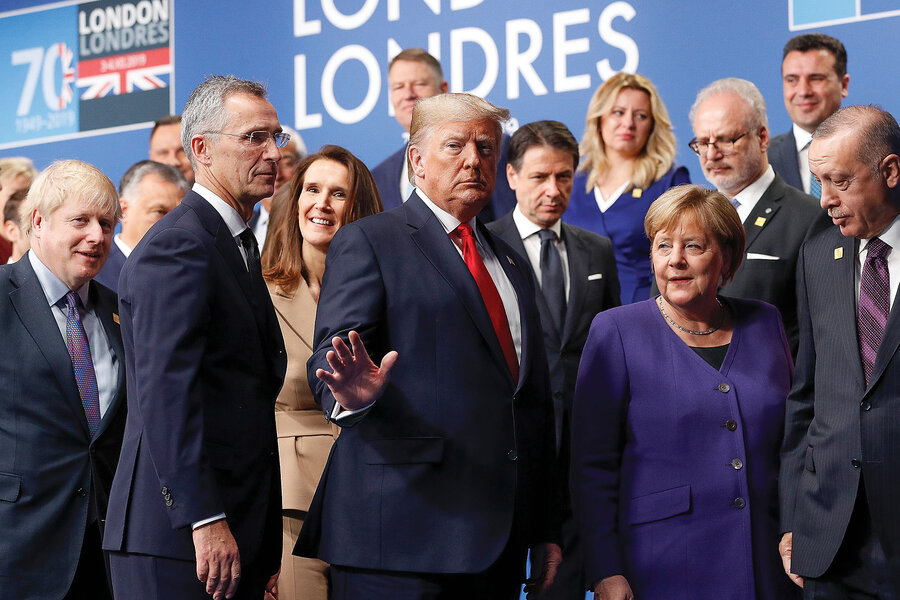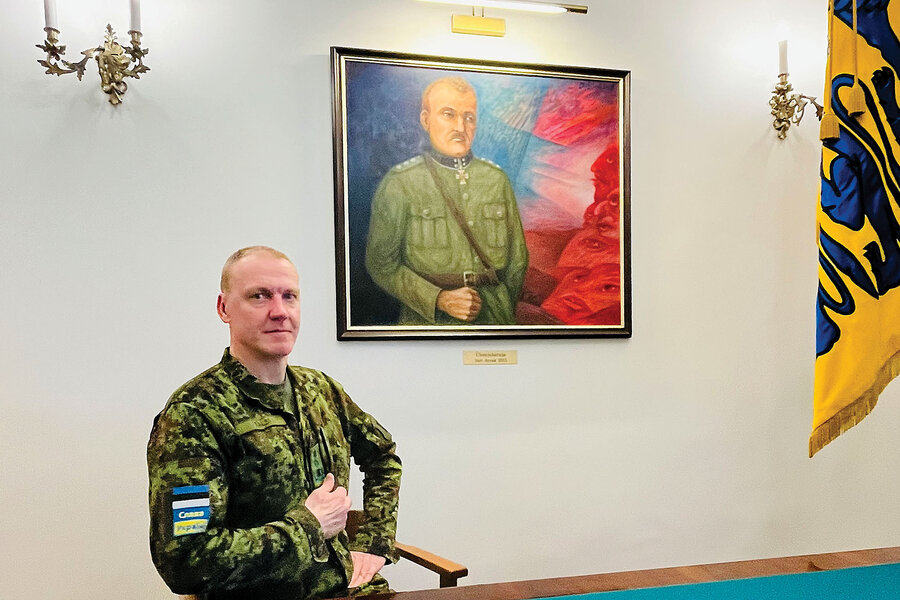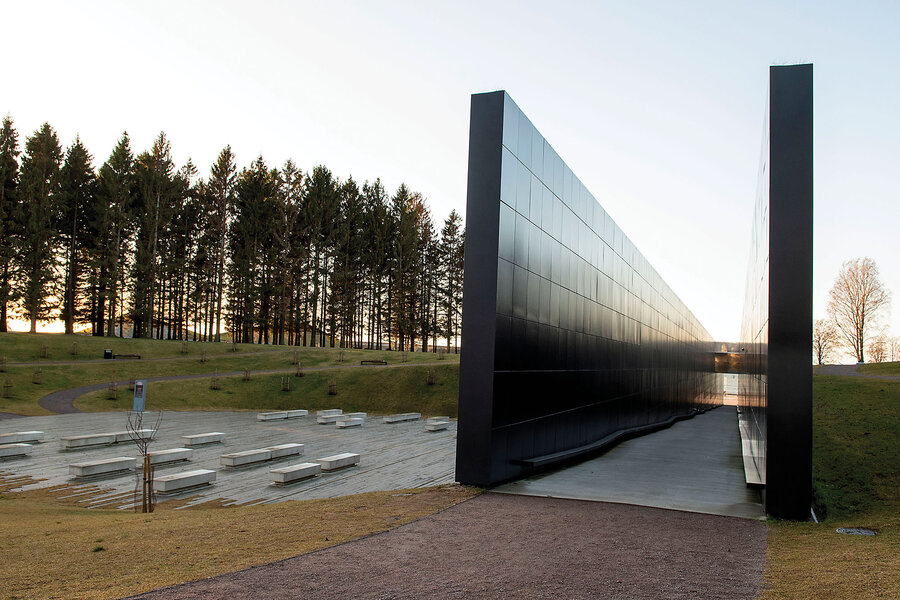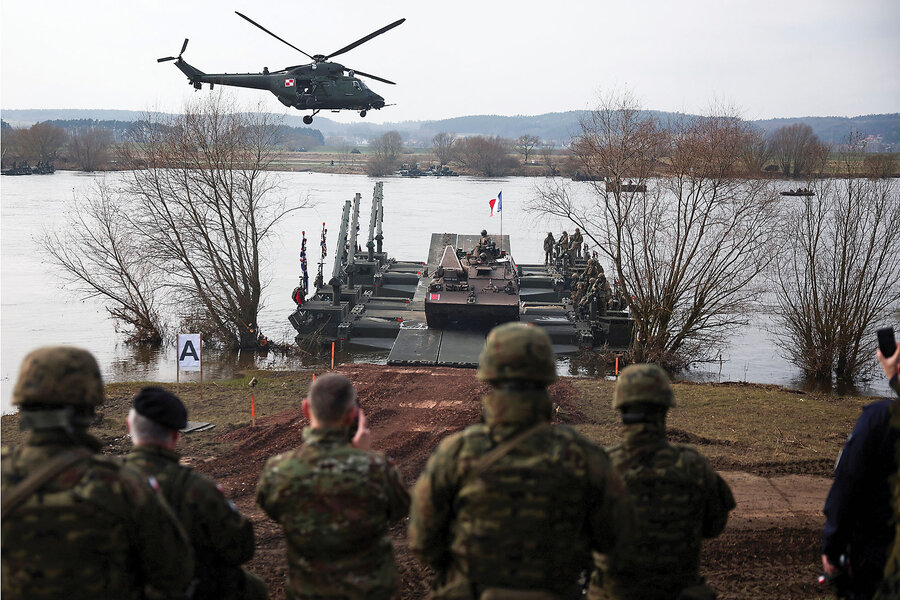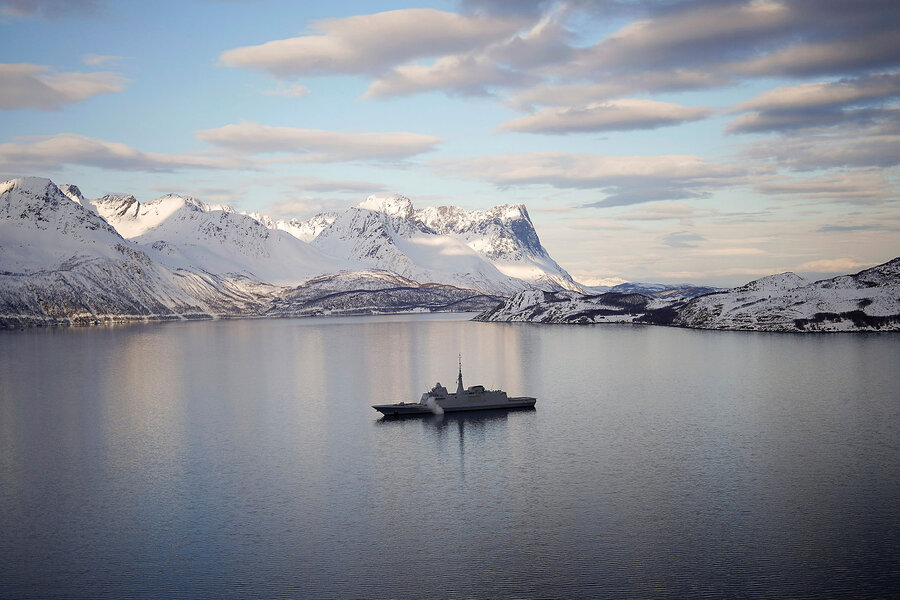NATO has united the West for 75 years. Here’s why it still matters.
Loading...
| WASHINGTON; IMATRA, Finland; TALLINN, Estonia; KORZENIEWO, Poland; and STOCKHOLM
As NATO marks its 75th anniversary on April 4, leaders of the 32 member states are celebrating what is widely considered the greatest and most effective military alliance in history.
NATO was part of the postwar architecture of multilateral organizations – largely designed by the United States – whose aim was preventing a third world war and building global economic stability. Yet it was also at the visionary forefront of reaching for those goals from a foundation of core principles: democratic governance, universal human rights, and the rule of law.
Why We Wrote This
A story focused onFor 75 years, NATO has brought peace and prosperity to Europe, the United States, and their allies. Now a grueling war in Ukraine heralds severe tests ahead for the alliance.
To that list of values, the alliance added trust, which derived from each member’s pledge under Article 5 to come to the defense of any fellow member that came under attack. Superpower America’s promise of defense provided the bedrock for that trust to flourish.
NATO succeeded in halting the grim succession of wars in Europe, triumphed in the Cold War with the Soviet Union, and then helped build a united and prosperous Europe by welcoming many former Soviet republics into the club.
“The fundamental reason” for the alliance’s unparalleled success is that “the leaders in Europe and America – having lived through two world wars – realized that the best and most practical way to prevent a third was not for America just to join in addressing a war once one started, but for America to be in Europe to prevent a war from ever starting,” says Ivo Daalder, U.S. ambassador to NATO under President Barack Obama.
“At the very core of this success is trust,” he says.
Fighter jets scrambled low and loud, prepared to quash enemy fire, as military vessels quickly ferried tanks across Poland’s longest river, the Vistula.
The exercise, NATO’s largest since the Cold War, was part of a five-day, 32-country show of strength in early March involving 90,000 troops. The operation tested just how quickly the alliance could speed reinforcements to Poland’s eastern border should Russia invade a member nation.
“We need to be ready – and we are ready – to fight tonight,” says U.S. Maj. Gen. Randolph Staudenraus, a NATO operations specialist, surveying the scene.
Why We Wrote This
A story focused onFor 75 years, NATO has brought peace and prosperity to Europe, the United States, and their allies. Now a grueling war in Ukraine heralds severe tests ahead for the alliance.
But there was another reason for the impressive display of trans-Atlantic coordination and unity: to demonstrate that the military alliance born of the ashes of World War II remains just as relevant today to a newly destabilized Europe.
Indeed, as NATO marks its 75th anniversary on April 4, leaders of the alliance’s 32 member states on both sides of the Atlantic are celebrating what is widely considered the greatest and most effective military alliance in history.
Originally comprising 12 countries led by the United States, the North Atlantic Treaty Organization set out to secure a ruined and unstable Europe prone to devastating wars. Its success promoted decades of remarkable economic prosperity.
The alliance was part of the postwar architecture of multilateral organizations – largely designed by the U.S. – whose aim was preventing a third world war and building global economic stability. Yet it was also at the visionary forefront of reaching for those goals from a foundation of core principles: democratic governance, universal human rights, and the rule of law.
To that list of values, the alliance added trust, which derived from each member’s pledge under the treaty’s Article 5 to come to the defense of any fellow member that came under attack. Superpower America’s promise of defense provided the bedrock for that trust to flourish.
NATO succeeded in halting the grim succession of wars in Europe, triumphed in the Cold War with the Soviet Union, and then, in an ambitious expansion wave a decade after the fall of the Berlin Wall, helped build a united and prosperous Europe by welcoming many former Soviet republics into the club.
“The fundamental reason” for the alliance’s unparalleled success is that “the leaders in Europe and America – having lived through two world wars – realized that the best and most practical way to prevent a third was not for America just to join in addressing a war once one started, but for America to be in Europe to prevent a war from ever starting,” says Ivo Daalder, U.S. ambassador to NATO under President Barack Obama.
“At the very core of this success is trust,” he says. “NATO is not just a treaty or a legal obligation. It’s the confidence each member has in the highly elusive and difficult-to-define element of trust.” There’s trust in fellow members, he adds, “but also a trust that America would do something quite abnormal for a country to do, which is to defend them even when American territory is not directly affected or directly threatened.”
An anniversary summit in Washington in July is sure to trumpet a nearly eight-decade record of success. Yet many trans-Atlantic security analysts and diplomats caution that the celebrations in April and July must be tempered by recognition of the significant challenges the alliance faces, some of which may be self-inflicted.
First among them are Russia’s war in Ukraine and NATO’s failure at one of its core purposes, which was to prevent the return of war to Europe. Other stark challenges loom: growing disenchantment with multilateral management of global affairs, generally, and with the U.S.-led postwar architecture; and rising nationalist “America First” sentiments in the U.S. embodied by former President Donald Trump.
“The fact that the alliance has new members Finland and Sweden coming in and others aspiring to join is indicative of its enduring value,” says Ian Lesser, vice president of the German Marshall Fund and executive director of its Brussels office. “But at the same time, it’s fair to say that NATO was very seldom tested during the Cold War as seriously as it’s being tested today.”
Russia’s invasion of Ukraine has united NATO and given it a renewed sense of purpose, he says, “but that does not alter the reality of some big looming questions” that will define the future of trans-Atlantic security agreements.
Chief among those questions, Dr. Lesser says, is “the fundamentally shifting political atmosphere in the United States concerning alliances and the U.S. role in the world.” Perhaps of equal importance, he adds, is the “dismantling of the broader security
infrastructure that was part of NATO’s strength,” including arms control and strategic dialogues with adversaries, “to a point where it is virtually absent today.”
The hand-wringing over signs of weakening U.S. support for NATO – and for the U.S. maintaining its leadership role – intensified in February when Mr. Trump, at a campaign rally in South Carolina, cast doubt on whether, if reelected president, he would honor Article 5.
On the contrary, he boasted, he would “encourage” Russia “to do whatever the hell they want” to any member not reaching the NATO target of spending 2% of gross domestic product on defense. His remarks were reminiscent of when he was president-elect and called NATO “obsolete.”
In response, NATO officials point out that European members collectively do hit the 2% spending target. Moreover, Europe’s defense-spending trajectory is sharply upward. This year 18 members will spend the recommended 2% on defense, they say, compared with only three in 2014 when Russia annexed Ukraine’s Crimean Peninsula.
Mr. Trump received hoots and applause when he threatened to abandon European allies. But others point out that his remarks actually belie continuing strong support among Americans for NATO and for America’s global leadership role more broadly. A Gallup poll in February showed that a plurality of Americans, 47%, support the current commitment to NATO – that includes 20% who would support the U.S. increasing its commitment to the alliance.
One key factor in that continuing support is Russian President Vladimir Putin’s growing belligerence toward the West, extending to threats of nuclear war. His full-scale invasion in 2022 of an increasingly Western-oriented Ukraine with aspirations for NATO membership has also kindled support for the alliance across Europe, including in its newest members, Finland and Sweden.
In the years before Moscow’s invasion of Ukraine, the chief of defense command for the Finnish Defence Forces, Lt. Gen. Vesa Virtanen, enjoyed taking visitors to his nation’s border with Russia.
“I’d say, ‘Hey, look at that – no fences, nothing.’”
Finnish authorities simply painted tree trunks yellow as a mild warning to any wanderers in the dense, lake-dotted woodlands.
Today, fences are being erected and official crossings are currently closed.
Beneath a canopy of snow-dusted birch and spruce outside the border city of Imatra, Jussi Vainikka, captain of Finland’s border police for the country’s southeast, nods toward Moscow. He notes that this land is no longer just the line of demarcation between Finland and Russia: It is NATO’s newest frontier – 832 miles at its longest – with an increasingly unpredictable adversary.
NATO leaders have warned that the border is a target for Russian attacks, and last year Captain Vainikka bore witness to one of them. At the time, he saw it as an unusual “phenomenon” – waves of immigrants attempting to cross into Finland on bicycles, through the snow.
Alliance officials call it hybrid warfare – Russia attempting to weaponize immigrants by flooding the border and creating confusion. “This,” Lieutenant General Virtanen says, “was organized by Moscow.” The Kremlin has also made use of cyberattacks and disinformation campaigns.
Against this backdrop, the Article 5 pledge to come to the aid of embattled allies is reassuring – and was the driving impetus for Finland’s 2022 decision to join NATO, says retired Gen. Jarmo Lindberg, Finland’s chief of defense until 2019. For Finns, “the feeling is that [we are] now under the protection of NATO and Article 5,” he says, adding that national media often point out that “Russia has never attacked a NATO member nation.”
This trust in security through the alliance is a new development for Finnish citizens. Prior to Russia’s 2022 invasion of Ukraine, support for NATO membership hovered at 20%. Days afterward, it skyrocketed to 76%.
Soile Hellsten, whose home is just a few hundred yards from the border, experienced this evolution in thinking herself. Since Russia’s invasion of Ukraine, the possibility of war “is more in my head,” she says. “It’s a worry.” Joining NATO offers reassurance and a clear pathway to greater security, she says.
The closing of the border has negatively affected her gas station and cafe; Russians once made up about half of all customers for the region’s spas, cross-country ski resorts, and karaoke clubs. But Ms. Hellsten says she nonetheless supports Finland’s decision to join NATO and close the border for the time being.
Her reduced income is a small price to pay, she says, for the trust and enhanced confidence she now has in her family’s safety – and for the security of “all the people” of the alliance.
Some of the highest support for NATO among its members is found in former states of the defunct Soviet Union.
Since joining NATO, the Baltic states and countries of Eastern Europe have lived in peace and prospered. And they have exchanged the yoke of the Soviet Union’s communism for the freedoms and governing principles that come with alliance membership.
Estonia, the northernmost of the Baltic states, is a poster child for the benefits of membership.
“We’re a laboratory example that if you believe in these values, if you do the right things – freedom, free press, anti-corruption – then you get to security and prosperity,” says Kusti Salm, permanent secretary of the Estonian Ministry of Defense. Moreover, since Estonia gained its independence in 1991 (and joined NATO in 2004), its GDP has increased fortyfold.
“We’re 40 times richer than we were,” he says.
And if NATO membership comes at a price, most Estonians will tell visitors it’s well worth paying.
At the Victims of Communism Memorial in Tallinn, the country’s seaside capital, Maj. Gen. Veiko-Vello Palm, commander of the Estonian Defence Forces, traces his fingers along a firing squad’s bullet holes.
“This is what happens when we are hesitant,” says Major General Palm, “and don’t fight back.”
Since the Soviet Union’s collapse, Estonia has lived in the shadow of a looming Russian threat.
“There hasn’t been a single day when Russia hasn’t been either patronizing us – that’s the positive scenario – or bluntly, aggressively saying that these are Russian lands and [they] need to take them back. It’s absolutely clear that we have just one existential threat,” he adds, “and it’s Russia.”
The Estonian military has evolved considerably in the face of this threat. A member of the first class of conscripts in 1992, Major General Palm recalls sharing seven rifles among 300 soldiers and wearing civilian clothes to train because there was no money for uniforms.
Yet even as NATO membership has greatly enhanced a sense of security, the country has never allowed that to weaken an abiding belief in self-reliance. Indeed, despite all the talk at the moment about Article 5 and the principle of collective defense, the general says the Estonian military puts equal stock in Article 3, which outlines each member’s obligation for self-defense.
Out of a population of 1.37 million, roughly 220,000 are registered to serve and have received at least one year of military training. Every year, Estonia organizes snap exercises. When the government puts out the call to muster, reservists are expected to drop everything – and they do.
Indeed, given the Article 3 obligations, Mr. Salm of the Defense Ministry says there is some truth to Mr. Trump’s complaint that some NATO members aren’t paying their fair share.
“To be honest, when it comes to ... this key criticism, we totally agree,” he says. “The way you create military credibility is through defense investments – that’s how it works.”
Regarding Ukraine, he says it is only by NATO standing strong with Kyiv that it will be able to effectively confront Russia and “send the message I think everyone wants to hear: that you don’t impose your will militarily on other countries.”
Underlying all of this, Mr. Salm says, is how clear it’s become that Mr. Putin’s efforts to torpedo the alliance have backfired. “Russia’s strategic goal is to break us apart and to create great internal frictions,” he says. Instead, “we have ended up stronger and more united.”
At the Swedish Peace and Arbitration Society, which supports disarmament and democratization, membership has more than doubled – from 6,000 to more than 14,000 – since Sweden applied to join NATO in 2022.
Parents have been calling the organization’s central office in Stockholm, concerned their children could be conscripted to fight for NATO. At the same time, the society’s youth branch has been growing in the face of apprehensions about historically neutral Sweden – long a leader in the nonproliferation movement – joining a nuclear alliance.
Standing beneath signs that read “No Tanks” and “Yes Peace,” Kerstin Bergeå, the organization’s president, bemoans what she says was the undemocratic manner in which her country decided to apply for NATO membership. It “was a very hasty process,” she says. “There wasn’t any debate, really, with the Swedish public – and we’re used to being consulted.”
Yet Sweden’s accession to NATO – made possible when Hungary finally approved the membership bid in February – has garnered growing majorities of support among Swedes ever since Russia invaded Ukraine. Polls show most believe their country, long a NATO partner, will be more secure and better able to defend against an aggressive Russia from inside the NATO tent.
Indeed, for many Swedes, the alliance’s central appeal is trust that the U.S. would come to their aid in the event of an attack, says Hampus Ledberg, as he walks behind his bundled-up toddler on a rainy Stockholm street.
Militarily, “the only guys who matter are the United States,” he says. He expresses confidence that the U.S. would indeed come to Sweden’s defense, despite Mr. Trump’s recent comments, and says for that reason alone Sweden is right to join. “It’s long overdue,” he says.
Still, as the NATO skeptics at the Peace and Arbitration Society suggest, not everyone is enthusiastic about membership.
For some, it commits Sweden to spending too much on defense at the expense of domestic priorities. For others, it means their country is turning its back on its traditional role as a neutral promoter of global peace – and in particular, of nuclear disarmament.
“We have a broader perspective on what’s making the world a safer and more secure place in the long term,” Ms. Bergeå says.
She points to steps the government is taking that go against her sense of Sweden’s role in the world.
The military budget doubled to $12 billion between 2020 and 2024. And as the state has increased spending on weapons, she says, it has cut back on education, health care, and programs targeting Sweden’s growing gang problem.
Moreover, some worry that NATO’s latest expansion will only further incite Russia and lead not to greater security but to heightened instability. Indeed, Mr. Putin wasted little time in responding to the approval of Sweden’s membership, announcing Russia would “significantly strengthen” its military in western Russia to counter what he said are NATO’s intensifying preparations to strike his country.
While the Swedish government has touted the benefits of NATO’s mutual defense treaty, critics say the obligations it likewise imposes haven’t been as well explained. For example, the government recently agreed to host U.S. troops at 17 of its military bases.
“We’ve obviously been presented with NATO membership in terms of what we will be getting,” Ms. Bergeå says. “But what are we expected to give?”
Such concerns are at the heart of why Sweden stayed nonaligned throughout the Cold War, says Magnus Petersson, head of Stockholm University’s department of economic history and international relations. “If you’re in an alliance,” he says, “you’re automatically dragged into the war if someone attacks your ally.”
Ms. Bergeå underscores Sweden’s shifting nuclear policy as evidence of how membership might make the world less safe.
At a 2022 nonproliferation conference, officials announced that as a NATO applicant, Sweden, long an ambassador for disarmament, could no longer endorse the position that nuclear weapons should never be used again under any circumstances.
“Proof,” Ms. Bergeå says, “that we are going the wrong way.”
Indeed, for some critics, one needn’t be a peacenik, or Donald Trump, to argue that NATO has not only outlived its useful purpose, but is actually a threat to European peace and even U.S. security interests.
“I was wrong to think at one time that NATO is obsolete, because it’s actually worse than obsolete: It’s become a cause of global insecurity,” says Michael Desch, founding director of the University of Notre Dame’s International Security Center in Indiana. “The biggest war in Europe since World War II was caused by NATO expansion,” he says, referring to Russia’s war in Ukraine. “There’s just no way to get around that.”
NATO accomplished what it was created to do, he says, which was to defend Europe and the U.S. against the Soviet Union. But instead of celebrating a “mission accomplished” and turning out the lights, Dr. Desch says, the alliance disregarded warnings and “decided to go big by going east.”
It’s NATO’s expansion to Russia’s borders that has triggered “what Russia was making very clear all along this was going to lead to,” he says – namely, the “destabilization” of Europe. “So now we’re in a place where the newest members of NATO, the front-line states, are advocating jihad against Russia,” he adds. “NATO has created the problem which is now its purpose.”
Dr. Desch acknowledges with a chuckle that he is unlikely to be invited to speak at NATO’s Washington summit. But he also insists his views are not as far out of the mainstream as some might think.
“No doubt the foreign policy establishment would consider this kind of thinking ... a minority position,” he says. “But ... it resonates outside the elites in important ways,” he adds, referring for example to the head winds that additional military aid to Ukraine has faced in Congress.
“The world has changed a lot since 1989, especially with the rise of China to great-power status,” Dr. Desch says. “I have no problem with building alliances and bilateral relationships,” he adds, “but today that needs to be with Southeast Asia and partners in the Indo-Pacific.”
Even for NATO’s most ardent supporters, the worst thing it could do to mark its 75th anniversary would be to limit the summer’s summit to a celebratory bash featuring self-congratulatory speeches about a strengthened and united alliance.
Because NATO has work to do.
As Mr. Daalder, the former ambassador, says, you don’t have to be in the
“obsolete” camp to understand that the trans-Atlantic relationship has to change in significant ways as the U.S. and Europe confront today’s world.
Perhaps most critically, he says, Europe must in short order be able to take on more of its own security needs.
Calling himself the “embodiment of the trans-Atlantic alliance,” Mr. Daalder – now CEO of the Chicago Council on Global Affairs – notes that his mother survived the Holocaust, while his father survived a winter of starvation in occupied northern Holland. Both were beneficiaries of America’s entry into WWII.
Born in the Netherlands, Mr. Daalder left as a teenager to study in the U.S. – eventually writing his doctoral dissertation on NATO nuclear policy at the Massachusetts Institute of Technology in 1989.
Two decades later, he became the U.S. ambassador to NATO. “Imagine what it meant,” he says, for a boy born in Holland “to become the American president’s representative on everything about European and trans-Atlantic security.”
Still, he says the writing is on the wall portending a different trans-Atlantic relationship from the one he’s known.
“Joe Biden is very probably the last American president with European security on his brain,” he says. That changing of the guard was underscored by Senate Minority Leader Mitch McConnell’s announcement that he would step down from Senate leadership at the end of the year.
Senator McConnell said he had come to realize that his own foreign policy views – inspired by Ronald Reagan and his conception of America’s role as a global champion of freedom and universal values – are increasingly at odds with the Republican Party.
To be viewed as a success, the Washington summit will have to deliver “clarity” on Ukraine’s path to joining NATO, Mr. Daalder says. Moreover, if additional U.S. military assistance to Ukraine has not come through by then, it will cast a pall over the gathering, he adds.
But for the alliance’s long-term viability, even more critical will be the laying of a foundation for a more self-sufficient “European defense pillar” within NATO.
“Doing so will make it more likely the United States stays engaged in Europe,” he says, “rather than turning away.”
Editor’s note: This article has been updated to clarify Lt. Gen. Vesa Virtanen’s title. He is the chief of defense command for the Finnish Defence Forces.




